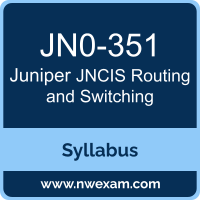 A great way to start the Juniper Networks Certified Specialist Enterprise Routing and Switching (JNCIS-ENT) preparation is to begin by properly appreciating the role that syllabus and study guide play in the Juniper JN0-351 certification exam. This study guide is an instrument to get you on the same page with Juniper and understand the nature of the Juniper JNCIS Routing and Switching exam.
A great way to start the Juniper Networks Certified Specialist Enterprise Routing and Switching (JNCIS-ENT) preparation is to begin by properly appreciating the role that syllabus and study guide play in the Juniper JN0-351 certification exam. This study guide is an instrument to get you on the same page with Juniper and understand the nature of the Juniper JNCIS Routing and Switching exam.
Our team of experts has composed this Juniper JN0-351 exam preparation guide to provide the overview about Juniper Enterprise Routing and Switching Specialist exam, study material, sample questions, practice exam and ways to interpret the exam objectives to help you assess your readiness for the Juniper JNCIS-ENT exam by identifying prerequisite areas of knowledge. We recommend you to refer the simulation questions and practice test listed in this guide to determine what type of questions will be asked and the level of difficulty that could be tested in the Juniper JNCIS Routing and Switching certification exam.
Juniper JN0-351 Exam Overview:
|
Exam Name
|
Enterprise Routing and Switching Specialist |
| Exam Number | JN0-351 JNCIS-ENT |
| Exam Price | $300 USD |
| Duration | 90 minutes |
| Number of Questions | 65 |
| Passing Score | Variable (60-70% Approx.) |
| Recommended Training |
Junos Intermediate Routing Junos Enterprise Switching |
| Exam Registration | PEARSON VUE |
| Sample Questions | Juniper JN0-351 Sample Questions |
| Practice Exam | Juniper Networks Certified Specialist Enterprise Routing and Switching Practice Test |
Juniper JN0-351 Exam Topics:
| Section | Objectives |
|---|---|
| Layer 2 Switching or VLANs |
- Identify the concepts, operations, or functionalities of Layer 2 switching for the Junos OS:
- Describe the concepts, benefits, or functionalities of VLANs:
- Demonstrate knowledge how to configure, monitor, or troubleshoot Layer 2 switching or VLANs:
|
| Spanning Tree |
- Describe the concepts, benefits, operations, or functionalities of the Spanning Tree Protocol (STP):
- Demonstrate knowledge how to configure, monitor, or troubleshoot Spanning Tree:
|
| Layer 2 Security |
- Identify the concepts, benefits, or operations of various Layer 2 protection or security features:
- Identify the concepts, benefits, or operations of Layer 2 firewall filters:
- Demonstrate knowledge how to configure, monitor, or troubleshoot Layer 2 security:
|
| Protocol Independent Routing |
- Identify the concepts, operations, or functionalities of various protocol-independent routing components:
- Demonstrate knowledge how to configure, monitor, or troubleshoot various protocol-independent routing components:
|
| OSPF |
- Describe the concepts, operations, or functionalities of OSPF:
- Demonstrate knowledge how to configure, monitor, or troubleshoot OSPF:
|
| IS-IS |
- Describe the concepts, operations, or functionalities of IS-IS:
- Demonstrate knowledge of how to configure, monitor, or troubleshoot IS-IS:
|
| BGP |
- Describe the concepts, operations, or functionalities of BGP:
- Demonstrate knowledge of how to configure, monitor, or troubleshoot BGP:
|
| Tunnels |
- Identify the concepts, requirements, or functionalities of IP tunneling:
- Demonstrate knowledge of how to configure, monitor, or troubleshoot IP tunnels:
|
| High Availability |
- Identify the concepts, benefits, applications, or requirements for high availability in a Junos OS environment:
- Demonstrate knowledge of how to configure, monitor, or troubleshoot high availability components:
|
Juniper JNCIS-ENT Exam Description:
This track enables you to demonstrate competence with networking technology in general and Juniper Networks enterprise routing and switching platforms. JNCIS-ENT, the specialist-level certification in this track, is designed for experienced networking professionals with beginner to intermediate knowledge of routing and switching implementations in Junos. The written exam verifies your basic understanding of routing and switching technologies and related platform configuration and troubleshooting skills.
